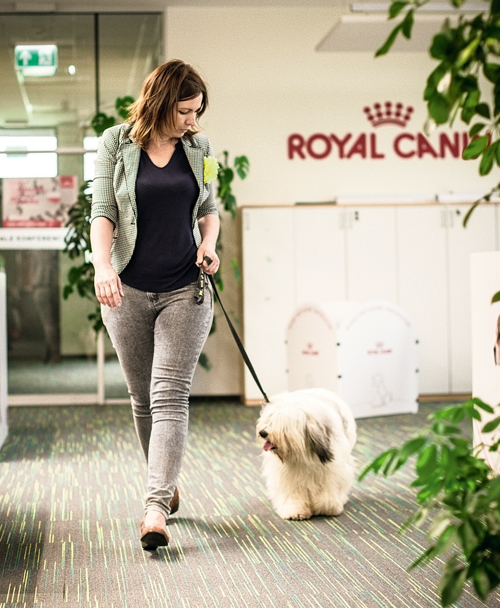4 legs good
Office & mixed-use development
There are at least two ways you can do this. The first is to quietly bring the dog in. Perhaps no one will notice. But even if we are talking about quite a small breed, it’s going to be noticed eventually. “Bringing animals into the office has to be officially organised, carried out methodically, and so some thought has to go into how it’s done,” argues Sybilla Berwid- Wójtowicz, a doctor in veterinary sciences and lecturer in animal psychology at the Warsaw University of Life Sciences, and who also works for Nestlé Purina Polska. “In many companies employees can bring their dogs only with the tacit consent of their colleagues and sometimes the boss will indulge it... and then everything goes well until there’s problem – say, the dog bites someone, destroys something or somebody simply doesn’t like it,” she explains.
Pet food producer Nestlé Purina runs the ‘Pets at Work’ programme, which allows pets to accompany people to work in a way that is regulated and amenable to everyone – dog lovers and haters as well as the four-legged creatures themselves and their owners. The scheme has been in place in European branches of the company since 2003 and forms one of the key planks of its corporate culture policy, while in Poland ‘Pets at Work’ has been in force since March 2016, when the company moved to its new local HQ, occupying several floors of Nestlé House in Warsaw’s Mokotów district. Purina’s rival, Royal Canin, has also been running its own ‘Animal-Friendly Office’ campaign since 2011, encouraging staff to bring their furry friends to the office. A few bewhiskered regulars are now checked in at the reception desks of both companies each day.
Where to start?
Both companies agree that the idea of sharing office space with pets should not pit employees against each other or force anybody to have to put up with dogs unless they wish to do so. “This is why the first stage of introducing dogs to the office should be an anonymous survey of the company. Each employee is asked just one question: do you want to have dogs in your office?” reveals Sybilla Berwid-Wójtowicz. “You do not have to justify your answer – it’s enough just to write ‘yes’ or ‘no’. Only one negative answer is needed for the scheme to be cancelled,” she adds.
“However, something good might result even from such a negative outcome – it’s worthwhile directing the positive energy it generates in the company into other activities aimed at improving animal welfare, such as volunteering or the collection of items for animal shelters. However, let’s assume that all the employees agree. The dogs that are brought to Nestlé House by their owners are first examined by an animal behaviourist to determine whether they are adequately socialised. The dog’s residency in the office starts out with a few short visits, to give the animal a chance to familiarise itself with the new environment. In new places dogs often get very excited, they explore the space extensively, but then they get used to it after a few times and start to treat the office as their second home. After a trial period an objective conclusion can be reached on whether coming to the office is good for the dog and other staff. “If it turns out during the trial period that the dog cannot cope with the office equipment, for example, if they bark at the coffee machine or they are scared of walking on a shiny, slippery floor, they are not forced to do this and can stay at home,” explains Sybilla Berwid-Wójtowicz of Nestlé Purina.
Office dogs must be regularly wormed and vaccinated. Dogs that are visibly ill or dirty are not allowed into the office and it is not permitted to bring puppies. “Dogs do not have to be formally trained, but they should be able to react to their owner’s commands, such as: sit, stay and, of course, to come to heel if they are asked to. According to the law as it stands, dogs must be under their owners’ control and this means by voice command or the use of a leash of up to two metres,” explains Sybilla Berwid-Wójtowicz.
Like a family
The areas that animals have access to are clearly marked out in Nestlé Purina’s offices, as are the areas where they are not allowed to go. Adequate signage in this regard is to the advantage of dog owners as well as people who want to avoid any canine encounters. You also need to secure any potentially hazardous areas and equipment. A passport confirming that the dog has all the desired character traits and skills acts as a formal pass to Nestlé House. The company also registers each time an animal enters or exits the building. How-ever, it is not possible to organise everything in this way in an office building that has many tenants. “I had intended to reserve one of the lifts for owners and their dogs as well as furnish it with suitable marketing materials,” adds Sybilla Berwid- Wójtowicz. “I wanted to make it possible for the employees who do not want to encounter animals to avoid this. Unfortunately, the system in our new office building allocates a lift to the user according to the floor they are going to, so choosing a specific lift is not possible,” she explains.
Ultimately, a Solomon-type solution was adopted – small dogs that can be carried can travel in any lift and the larger ones have to use the stairs and specially marked entrances. Those who don’t want to come upon a dog when climbing the stairs can use another staircase. “Our situation is easier because we are the only owner of our premises, so we can lay down the rules for how it is used,” points out Radek Popiel, the head of corporate affairs at Royal Canin. “All our employees can come to work with their dogs as long as they adhere to the internal regulations. The regulations are not complicated; they boil down to taking care of animals’ and people’s well-being,” he emphasises.
There is a large amount of green space around the offices of Royal Canin, which are situated in an industrial park in Niepołomnice. The company also has its own dog enclosure, so the conditions for them could even be said to be excellent. The building, even though it is exclusively occupied by the company, also had to be specially prepared before it could welcome animals. This included providing water and food bowls as well as beds and mats for the dogs. Each employee who brings their dog to work has a flag on their desks informing others about the presence of the animal. “Dogs can stay in designated zones of the office and their owners have partitions near their desks, which can be used to seclude the animal if they want to have a nap, for example,” says Radek Popiel of Royal Canin. “They have a lot of freedom in the office section as long as they are under the supervision of their owner. However, there are places that are off-limits to them – the warehouse, for security reasons, and the factory floor, because of health and safety requirements,” he adds.
Both Nestlé Purina and Royal Canin provide professional support for other companies that would like to allow animals onto their premises. Purina encourages them to join the Pets at Work Alliance and has set an ambitious goal for itself – around 200 companies embracing the concept by 2020. “We are eager to offer advice to other companies that want to run such a scheme in their offices,” declares Radek Popiel. “One of our neighbours in the industrial park consulted us on adapting their offices to allow people to come to work with their pets. We assisted them in this and now dogs can be seen in the company’s office,” he reveals.

The hair of the dog
But why bring your dog to the office in the first place? Because it is a classic win-win situation – everyone benefits: the animals are not left to pine on their own at home; they are given the company of friendly people; the dog owners themselves are not left with a feeling of guilt and can spend more time with their pets; the stress levels of other office workers are reduced, the employer benefits from an improved atmosphere in the office; while the company’s image is given a boost – and it stands out on the job market and among its rivals. Scientific research has confirmed that the presence of animals lowers blood pressure and cholesterol levels, reducing feelings of loneliness while also enhancing your self-esteem and thus avoiding the onset of depression. Meanwhile, the PAWrometer survey carried out by Nestlé in the US has revealed that more than 90 pct of employers who have opened up their offices to pets have observed an increase in the morale and loyalty of their staff as well as a reduction in stress levels and an improvement in the relations between them.
Of course not everyone likes dogs, so they are not always welcomed by everyone in the office. This might be for a number of reasons – from ordinary dislike, to allergies and phobias. However, the wishes of dog-lovers and haters can actually be reconciled at work. “The dog zone in the office must be clearly defined and marked out, so that people who do not want to come into contact with them don’t have to. This also deals with the issue of what people with allergies or phobias should do. No special measures need to be taken, provided the zone is well organised and they are not put in any discomfort,” insists Sybilla Berwid-Wójtowicz of Nestlé Purina. “However, the process for recruiting new people into the company should be modified – they need to be informed from the outset of the recruitment process of the presence of dogs in divisions of the company.
“Such issues can be addressed if we approach the matter emphatically – you have to empathise with the situation of animals who sit all day alone at home, as well as the feelings of people who don't like dogs or are scared of them,” claims Mikołaj Kusiak, the development director of Inwermer (who himself owns a Labrador). “It should be pointed out that people suffering from allergies or phobias cannot actually avoid encountering dogs on narrow pavements, on the bus or in their blocks of flats. But accidental or incidental contact with a calm animal at the office does not make things any better or worse for such people,” adds Mikołaj Kusiak.
 “The presence of dogs in office buildings is simply an organisational issue for us, which can be solved with the right approach and a little tact,” insists Mikołaj Kusiak of Inwemer
“The presence of dogs in office buildings is simply an organisational issue for us, which can be solved with the right approach and a little tact,” insists Mikołaj Kusiak of Inwemer
The dog’s life of a facility manager
The increasingly popular trend of bringing your dog to the office does pose some very real challenges for the owners and managers of office buildings. The regulations for the majority of commercial properties often include a ban on the presence of animals. However, if the fashion for office dogs becomes more widespread, such internal rules will require modifying. Most facility managers view the growing number of four-legged guests with a philosophical detachment.
“If dogs are to be allowed into a building, we will need to buy deodorising products, to use more cleaning products and have more wash mats at the entrances, so the cleaning service has to be prepared for this,” adds Mikołaj Kusiak of Inwemer. “The costs are not high but the manager has to calculate them,” he adds.
“The manager’s most important task is maintaining harmony for all the building’s users and addressing their needs. Office space is a meeting place for people with differing beliefs and interests,” points out Michał Nowak, a maintenance expert at Sodexo Polska On-site Services. “Animals have a civilising effect, they can reduce stress and undoubtedly have a positive impact on the atmosphere at work. However, it has to be borne in mind that they also have minds of their own and can have a good or a bad day,” he adds. All the managers we spoke to agreed that if animals are to be allowed into a building, first there should be a ‘round table’ debate between the owners and managers of the building, the tenants and sometimes even the suppliers of services and materials. This discussion should result in the laying down of principles of co-existence for the people and animals in the building and should also address the issues of responsibility for possible damage and how such costs are to be covered.
“The presence of dogs in office buildings is a sign of the times and for the manager it is another organisational issue that can be solved with the right approach and a little tact,” insists Mikołaj Kusiak. “We have become accustomed to the fact that office buildings are not only work places but increasingly resemble self-sufficient towns. Did anybody imagine ten years ago that nursery schools, fitness clubs or changing rooms with showers for cyclists could be set up in office buildings? Until quite recently such amenities were regarded as something exotic that could only be seen in office parks in Western Europe, but they have since become the norm in Poland,” he concludes.






















































